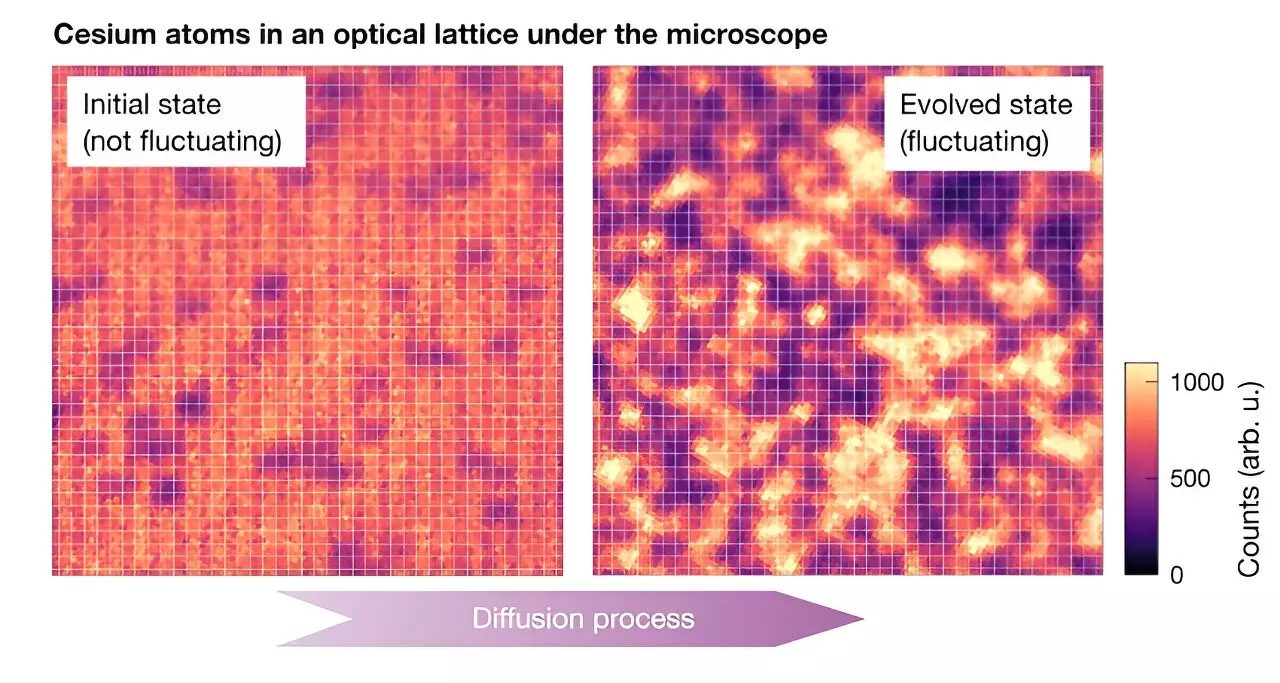The intricacies of quantum systems have long posed significant challenges to researchers striving to unravel their complex behaviors. A recent study by researchers from Ludwig-Maximilians-Universität, the Max-Planck-Institut für Quantenoptik, the Munich Center for Quantum Science and Technology (MCQST), and the University of Massachusetts sheds light on this complexity through innovative approaches and theoretical frameworks. The findings, published in Nature Physics, center on a powerful concept known as fluctuating hydrodynamics (FHD), which serves as a bridge between classical and quantum mechanics, aiming to simplify the understanding of chaotic quantum systems.
At the heart of this research is the utilization of a quantum gas microscope—a cutting-edge experimental apparatus designed to manipulate and image ultracold atomic gases with remarkable precision. This technology enables researchers to observe individual atoms, offering unprecedented insight into the dynamics that govern many-body quantum systems. Julian Wienand, a co-author of the study, emphasizes the challenges of simulating the behavior of numerous particles in a confined space. While calculations can become unwieldy as the particle count increases, the application of hydrodynamic principles provides a potent alternative.
Instead of tracking every individual particle’s movements, FHD allows researchers to understand the collective behavior of particles as a continuous density field, where typical particle interactions can be regarded as random fluctuations akin to white noise. This simplification facilitates the application of differential equations to quantify system dynamics, ultimately providing a better grasp of how these chaotic systems evolve.
Fluctuating hydrodynamics extends classical hydrodynamics by incorporating thermal fluctuations, thereby illuminating the behavior of systems previously deemed too intricate to model effectively. In classical physics, the expected outcomes of large ensembles can often be inferred from simpler models; however, the unique nature of quantum systems introduces phenomena such as entanglement, which disrupt the correlation between macroscopic behavior and microscopic properties.
The ability of FHD to describe chaotic quantum systems represents a significant advancement. The study presents convincing evidence that FHD is capable of expressing the dynamics of such systems both qualitatively and quantitatively, suggesting that, despite the seemingly chaotic microscopic interactions at play, the macroscopic properties of the system can be encapsulated by a succinct description involving a primary quantity—the diffusion constant.
Utilizing cesium (Cs) atoms, the researchers conducted a series of well-structured experiments by first entrapping the atoms in a laser-induced optical lattice and subsequently disturbing the lattice to incite interactions among the atoms. This process allowed the many-body quantum system to engage in a diffusion process, thereby emulating conditions under which thermalization occurs
Throughout the experiment, the team meticulously observed the evolution of fluctuations and their correlation to theoretical predictions. The data collected during this process illuminated the applicability of the FHD framework to describe the chaotic behaviors observed in quantum systems. By measuring diffusion constants and relating them to established theoretical principles, the researchers favorably affirmed the robustness of FHD in addressing quantum system complexities.
This groundbreaking research paves the way for future investigations that will expand the application of FHD in various quantum contexts. Many questions remain open about how fluctuations behave in systems that do not reach thermal equilibrium and how higher statistical moments—such as skewness and kurtosis—interact within these settings. The adaptability of FHD to cater to more complex observables contributes significantly toward bolstering our understanding of quantum mechanics.
The insight gained from establishing a link between equilibrium and non-equilibrium conditions through FHD adds a powerful tool for researchers. Such connections hint at the striking possibility that while quantum systems may be governed by intricate dynamics, they still exhibit overarching qualitative behaviors typical of classical systems.
The culmination of efforts from this multidisciplinary research team represents a noteworthy stride in resolving the enigmatic behaviors of chaotic quantum systems. By introducing fluctuating hydrodynamics as an effective theoretical framework, this study not only enriches our understanding of quantum mechanics but also reinvigorates the dialogue between classical and quantum physics. As researchers continue to explore further implications of these findings, the potential for dramatic advancements in our grasp of quantum phenomena becomes ever more tangible, signaling a future rich with possibilities for both theoretical insight and practical applications.


Leave a Reply